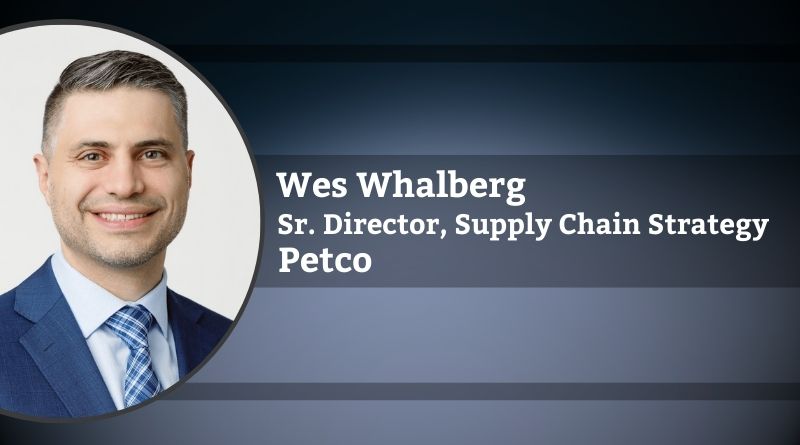Considerations In Supply Chain Modernization
By Wes Whalberg, Sr. Director, Supply Chain Strategy, Petco
Supply chains in companies older than 30 years often require technical or hardware modernization to operate or scale effectively into their next 30 years. Doing so is risky, however, and numerous failed attempts at supply chain modernization litter the landscape. This reality is one reason organizations hesitate significantly before investing heavily into their supply chain. Once the hesitation is overcome and the challenge of modernization is committed to, serious pitfalls that threaten success lie in wait.
Speaking specifically about large-scale robotic automation programs designed to modernize legacy manual operations, these five pitfalls routinely exist:
Pitfall 1: Thinking too small. Most organizations subscribe to a “Crawl, Walk, Run” program mindset and choose to modernize a single site, or a single part of a site, to “prove out” the solution and “work out the bugs.” The trap here is that modernizing any part of your supply chain takes significant effort and patience, and your company, as well as the suppliers, must pay their best attention to it. A small singular instance of an implementation within a vast national supply chain will not stay center stage for long before day-to-day operations or other programs distract the mission. Then, resources languish or move on to other things, leaving the project orphaned and largely underutilized. When it comes time to approve what would have been the next phase of the program, it will stall, having not achieved its benefits due to lackluster focus. The company must galvanize the program as a strategic need that will be rolled out nationally, secure funds, and build a cohesive team to support it.
Successful projects also tend to have lots of visitors, and you should welcome them. Some of these visitors will be other companies your supplier is taking through to gain future customers
Pitfall 2: Thinking too big. The flip side is dangerous as well. A company can try to build a third or fourth order business case on automation before the first order business case leaves the drawing board. A basic automated solution is difficult and disruptive enough, but once the engineers are told to “think outside the box” because “we won’t get the funding enhance it later,” the creativity can get out of hand and overly complicated designs are the result. The company must put guardrails on automated solution designs that demand simplicity and elegance. Too many moving parts, especially if they are designed by different suppliers who do not have a long history of working together, will cause pain points that are very costly to resolve and prohibit the success of your program.
Pitfall 3: Not including enough people. There are key stakeholders in any automation program – Operations, IT, Engineering, HR, and Finance, to name a few. Other groups, typically less involved, may find out too late that they have important or essential information to share. These groups include, but are not limited to, Internal Audit (inventory control requirements), Real Estate (landlord requirements), Merchandising/Demand Chain (are you handling their products differently than before? Is this a chance for them to make a change they have been looking to make?), and Risk (insurance requirements on your new system).
Pitfall 4: Losing track of the customer. Most organizations separate out Supply Chain/Logistics from Sales, and they each have different performance incentives. Often, Automation programs serve to improve the cost or quality metrics of the Supply Chain organization without fully considering whether it will have an impact on the sales organization or if it could drive a potential improvement to the sales organization. Optimizing your supply chain without considering the customer at every design phase risks subordinating the customer experience for the sake of efficiency upstream, which is never beneficial.
Pitfall 5: Assuming your supplier knows as much about your business as you do. Your supplier is very good at designing and implementing automated solutions, but you are the expert at running your operations. Understanding and communicating nuances in your business that will take you off the happy path is essential to designing flexible and robust solutions. Does your operation shut down for 1 hour a month to celebrate birthdays? Does the hopeful automated part of the building need to finish two hours before another part of the operation every day? If this criteria is not captured, it will not be accounted for in the design and will be a huge detriment to the solution’s effectiveness, either requiring redesign to repair or resulting in lower ROI than intended.
Top Positive Impacts: Successful projects that meet their ROI goals, besides achieving financial, quality, or other metrics, become magnets for enhancement projects and a pipeline for new talent that your company needs to stay successful. Successful projects also tend to have lots of visitors, and you should welcome them. Some of these visitors will be other companies your supplier is taking through to gain future customers. This allows you access to other like-minded individuals to create user groups with, share ideas and talent, and create strong bench strength in your newly automated competency. It also allows you to stay current with trends as upgrades and new capabilities become available. Having built a muscle in modernizing, be sure to flex it and keep it strong!

